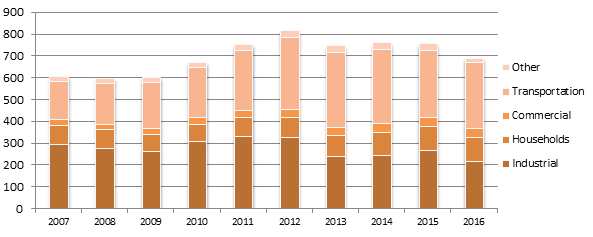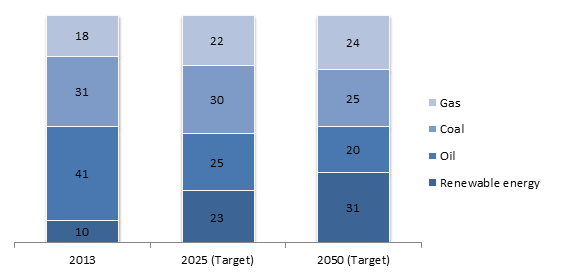Energy consumption within Indonesia had continued to increase until 2012 but then started to decline with the deceased energy consumption in Industry and Transportation sectors (See the below Figure). On the other hand, energy consumption in Households and Commercial sectors still continue to increase. In particular, the Households sector’s energy consumption has become 1.3 times greater over the past 10 years. This increase may be attributed to the spread of electric appliances due to the country’s economic growth and increased population.

Energy consumption by sector (unit: million BOE (Barrel Oil Equivalent))[1]
As shown above, energy consumption in Indonesia has been declining in recent years. The state’s policy and regulations on energy originates from the National Energy Conservation Master Plan (RIKEN: Rencana Induk Konservasi Energi Nasional) that was originally promulgated 25 years ago, in 1983. To date, RIKEN has been reviewed and updated for several times. The latest amendment in 2005 included the establishment of new key goal that aimed to reduce energy intensity by 1% annually. Then, RIKEN was incorporated into the Presidential Decree No 5 of 2006 on National Energy Policy. This Decree has set a specific goal of achieving energy elasticity of less than l in 2025.
Then, in 2014, the Government Regulation No. 79 of 2014 on the National Energy Policy (NEP) replaced the said Presidential Decree No 5 of 2006. The NEP was developed with the recognition that energy resources were not just goods for export as being in the past, but a capital source for the national development that supported prosperity of the nation’s people. It has set energy management goals to be achieved by 2050, reflecting the government’s strategy that aims to ensure the storage of energy resources by reducing gas and coal exports. The Policy, developed by the National Energy Commission, aims to give an energy management method that helps achieve self-sufficiency and storage of energy in Indonesia. Specifically, it stipulates the promotion of use of renewable energy, promotion of energy supply from domestic and international suppliers and improvement of energy production, transportation and distribution systems. The target values for primary energy sources are: 23% for renewable energy, 25% for oil, 30% for coal, and 22% for gas in 2025; and 31% for renewable energy, 20% for oil, 25% for coal, and 24% for gas in 2025 (see the figure below).

Trends in primary energy source composition (unit: %) (Target values for 2020 and 2025)
Legal system for energy conservation
In Indonesia, legal system for energy conservation can be summarized as below. The Law No. 30/2007 on Energy and the Government Regulation No. 70/2009 on Energy Conservation give goals of energy management and measures to be taken. Under these Law and Regulation, there are multiple Regulations of the Minister of Energy and Mineral Resources in force, mainly governing 1) energy efficiency control at factories and 2) energy conservation in products. Furthermore, there are specific rules for each regulated product.
Legal system for energy conservation:
- Law No. 30/2007 on Energy
- Government Regulation No. 70/2009 on Energy Conservation
- Factory
- Regulation of the Minister of Energy and Mineral Resources No. 14/2012 on Energy Management
- Product
- Regulation of the Minister of Energy and Mineral Resources No.18/2014 on Energy Efficiency Label for CFL
- Regulation of the Director General of New Energy, Renewable Energy, Energy Conservation No. 671/2014 on Energy Efficiency Test of Compact Fluorescent Lamp
- Regulation of the Minister of Energy and Mineral Resources No.57/2017 on Energy Efficiency Standard and Energy Efficiency Label for Air Conditioners
- Regulation of the Minister of Energy and Mineral Resources No.18/2014 on Energy Efficiency Label for CFL
- Factory
- Government Regulation No. 70/2009 on Energy Conservation
The Law No. 30/2007 on Energy, which consists of 10 Chapters and 34 Articles, addresses issues related to a national sustainable energy system. The below table summarizes the provision of Article 25 of the Law, which addresses energy conservation. The further detailed rules are stipulated by the Government Regulation No. 70/2009 on Energy Conservation.
- National energy conservation becomes the responsibility of the Government, regional government, business entities, and the people.
- National energy conservation as referred to in paragraph (1) covers all phases of energy management.
- Energy consumers and producers of energy efficient appliances who perform the energy conservation are given facilities and/or incentive by the Government and/or regional government.
- Energy sources consumers and energy consumers who do not perform the energy conservation are given disincentive bv the Government and/or regional government.
- Further provisions on the implementation of energy conservation as well as the provision of facilities, incentive and disincentive as referred to in paragraphs (1), (2), (3) and (4) are governed by the Government Regulation and/or regional regulation.
The Government Regulation No. 70/2009 on Energy Conservation provides rules specific to energy conservation management. Key provisions include: Chapter III Part 4 “Conservation in Energy utilization” (Articles 12 and 13) governing factory operation and Chapter IV “Standard and label” (Articles 15 and 16) governing product energy efficiency.
Regarding energy conservation at factory, those who use energy greater or equal to 6,000 equivalent tons of oil per annum in manufacturing or other processes are mandated to undertake energy conservation[2] through energy management. (Article 12 of the Government Regulation No. 70/2009). The details of the “energy management” stated here are provided in the Regulation of the Minister of Energy and Mineral Resources No. 14/2012 on Energy Management.
Energy conservation management in products is performed using an energy efficiency label scheme, which mandates energy performance standards for electric devices and equipment. Producers and importers of controlled device or equipment shall affix energy efficiency labels onto their products (Article 16 of the Government Regulation No. 70/2009)). Further provision on the labeling procedure and specific standard values are governed by a separate regulation of the Minister of Energy and Mineral Resources.
[1] The term “energy conservation” is defined as below in the Government Regulation No. 70/2009:
“a systematic, concerted and integrated efforts to conserve domestic energy resources and enhance efficiency in the utilization thereof.”
[2] Handbook of Energy & Economic Statistics of Indonesia
https://www.esdm.go.id/assets/media/content/content-handbook-of-energy-economic-statistics-of-indonesia-2017-.pdf

























